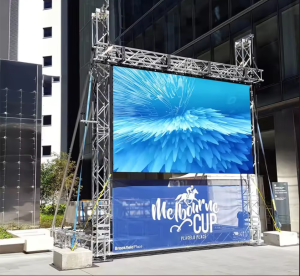
The difference between 3D LED displayand ordinary LED display
The 3D LED display on the street is truly breathtaking, with many people taking photos and sharing them on social media. Through this article, let’s explore the differences between 3D LED displays and ordinary LED displays.

3D LED Display vs. Ordinary LED Display: What Are the Differences?
Working Principle
When an LED is powered, it emits light to form a pixel. Thousands of such self-illuminating pixels combine to form an image, which is the principle behind an ordinary LED display.
3D LED displays build upon the light-emitting imaging principle of ordinary LED displays but incorporate additional technologies to create a greater sense of depth, such as columnar lenses, parallax barriers, and forced perspective, among other three-dimensional display techniques.
Visual Appeal
LED screens can be customized in terms of resolution, size, and brightness. Therefore, both ordinary LED displays and 3D LED displays feature high brightness, high clarity, and rich colors. However, 3D LED displays enhance visual depth, making the images more three-dimensional and vivid. When combined with large screens, 3D visuals create a more impactful visual experience.
Interactivity
Vivid and lifelike 3D visuals attract more people to take photos and check in. Some 3D LED displays also feature motion-recognition smart interactive functions, providing audiences with excellent interactivity and entertainment value.
Many ordinary LED displays on the market are equipped with intelligent technologies such as touch interaction, gesture recognition, and voice control. These intelligent ordinary LED displays allow audiences to actively change the displayed content, enhancing interaction between viewers and the LED screen.
The interactive directions of the two are different. 3D LED displays are more oriented toward long-distance interaction, slightly adjusting the angle of the display based on audience behavior to convey more stunningly realistic graphics, while ordinary LED displays are more oriented toward changing the displayed information based on audience preferences.

Content Creation
Content creation for ordinary LED displays is simpler and more flexible, with high adaptability for text, images, and videos. However, 3D LED displays have higher requirements for content creation, necessitating creative design and advanced technical skills. Professional 3D video production software must be used to generate 3D visuals, and only such professionally produced 3D content can achieve the desired immersive and three-dimensional effects.
Viewing Angle
The stereoscopic effect of 3D LED displays varies depending on the viewing angle. 3D LED displays are designed with corner LED cabinets, and combining 3D visuals with corner LED cabinets enhances the spatial sense of the visuals. However, this design means that the stereoscopic effect of 3D LED displays is strongest only when viewed from a specific angle, and the stereoscopic effect is slightly reduced when viewed from non-specific angles.
In contrast, ordinary LED displays have a broader viewing angle, typically around 160 degrees. Within this range, the image remains consistently clear and detailed regardless of the viewing angle.
Energy Efficiency
Although both are LED screens with high energy efficiency, 3D LED displays often prioritize visual effects, featuring large screens, high definition, and smooth performance. Additionally, most 3D LED displays are installed outdoors, requiring high brightness.
Larger screens and higher resolution require more LED diodes, smooth performance demands high-performance driver ICs, and higher brightness necessitates more power consumption. All these factors require additional energy to sustain operation.
Considering these factors, the vast majority of ordinary LED displays are more energy-efficient than 3D LED displays.
Cost
3D LED displays incorporate additional design elements that create visual illusions, resulting in higher manufacturing costs compared to ordinary LED displays. Additionally, content creation for 3D LED displays is more expensive, leading to higher overall usage costs.
Commercial Feasibility
Although both ordinary LED displays and 3D LED displays have a wide range of applications, the unique visual appeal of 3D LED displays makes them more eye-catching and effective for brand promotion in street advertising.
Ordinary LED displays are suitable for almost all industries, including advertising, stage performances, and commercial meetings. When choosing them, practicality is the primary consideration, and the overall cost of ordinary LED displays is lower than that of 3D LED displays. The commercial focus of the two differs to some extent.
Conclusion
Whether it is a 3D LED display or an ordinary LED display, we need to choose based on our own needs and budget. The best choice is the one that suits your needs.